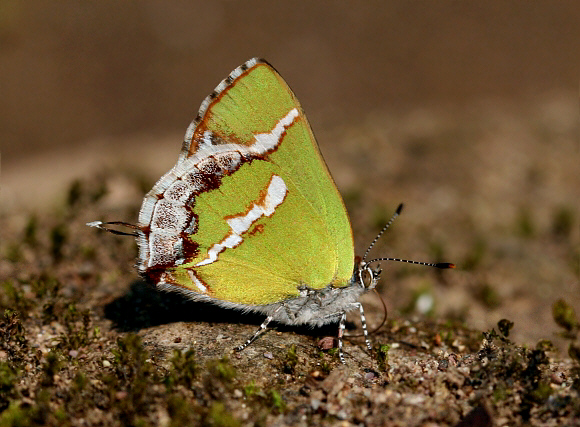
Introduction
Almost all neotropical Theclinae species are placed in the Eumaeini. The tribe is not particularly well represented in collections, so until fairly recently a high percentage remained unstudied, and were inappropriately filed away in the ‘convenience’ genus Thecla. Many taxonomists have attempted to rationalise the systematics of the Eumaeini, the most recent being Robbins who published a revision in 2004, reclassifying the taxa into 83 genera.
Currently there are 1058 known species. Taking into account their small size, secretive behaviour, and the great similarities between many species, it is estimated that about another 200 species probably remain to be discovered.
The genus Chlorostrymon comprises of 6 known species, variously distributed from Texas to Chile. The various species all have apple-green undersides, but differ in the configuration and extent of the white markings. The uppersides of the males are iridescent azure blue in all species, while the females are brown, with a trace of silvery blue scaling at the base of the wings.
The genus name Chlorostrymon is derived from Chloro – meaning ‘green’, and refers to the ventral wing colouration. The second part strymon is named after the Greek river Strymon. It refers to the river-like ‘hairstreak’ line on the underside of many Eumaeini genera, hence the names Strymon, Hypostrymon, Nesiostrymon, Phaeostrymon, Ministrymon, Chlorostrymon and Electrostrymon. The species name simaethis is derived from Simethis, an Oreadean nymph and companion to Artemis in Greek mythology.
Chlorostrymon simaethis is distributed from Texas to Chile, and also occurs in Jamaica and on some other Caribbean islands.
Habitats
This species is found in a huge variety of biotopes including rainforests, deciduous forests and high elevation scrub / desert. The altitudinal range extends from sea level to about 2800m.
Lifecycle
The eggs are shiny, green and laid singly on the fruits of Cardiospermum ( Sapindaceae ) or on the flowerbuds of Eupatorium shrubs ( Compositae ). The larvae are yellowish-green, marked with pale chevrons, and a pair of red spots midway along the back. They feed and develop within the seeds or buds of the foodplants.
Adult behaviour
Both sexes nectar at Eupatorium. The adults are usually encountered as singletons, and tend to sit motionless on flowers or foliage for long periods, but have a rapid and erratic flight, making it very difficult to locate them when they resettle. Males also imbibe moisture from damp mossy boulders.
